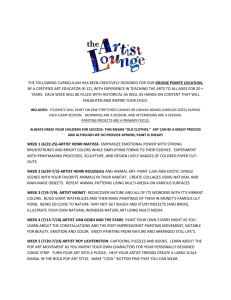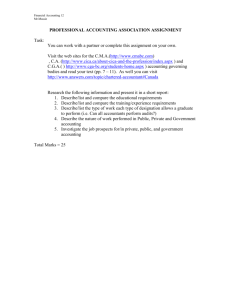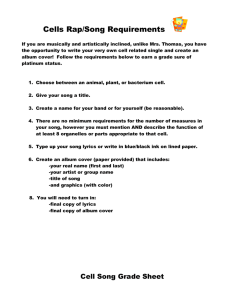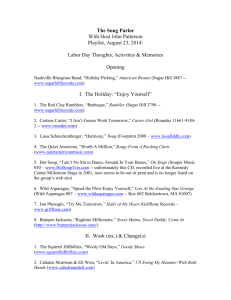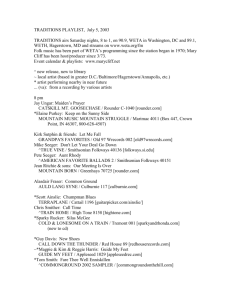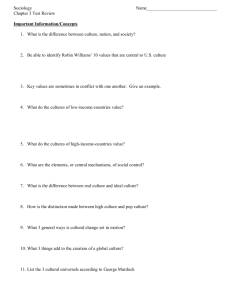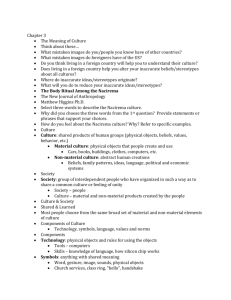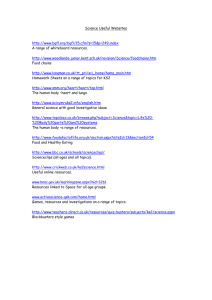Tour #1 - Sites at Penn State
advertisement
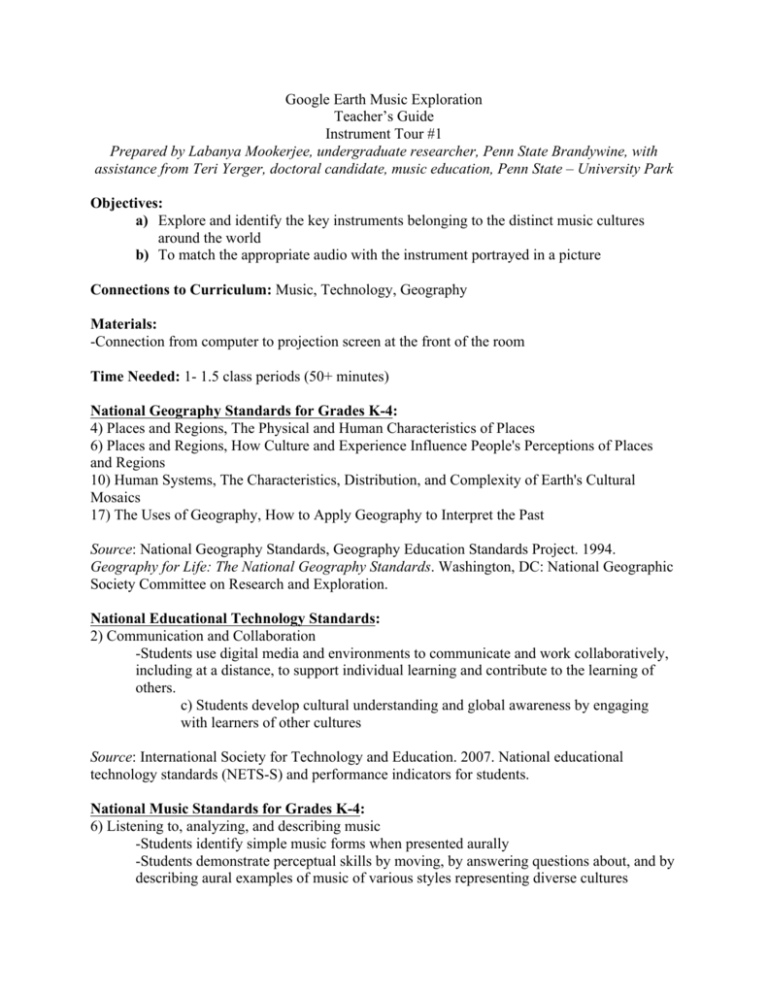
Google Earth Music Exploration Teacher’s Guide Instrument Tour #1 Prepared by Labanya Mookerjee, undergraduate researcher, Penn State Brandywine, with assistance from Teri Yerger, doctoral candidate, music education, Penn State – University Park Objectives: a) Explore and identify the key instruments belonging to the distinct music cultures around the world b) To match the appropriate audio with the instrument portrayed in a picture Connections to Curriculum: Music, Technology, Geography Materials: -Connection from computer to projection screen at the front of the room Time Needed: 1- 1.5 class periods (50+ minutes) National Geography Standards for Grades K-4: 4) Places and Regions, The Physical and Human Characteristics of Places 6) Places and Regions, How Culture and Experience Influence People's Perceptions of Places and Regions 10) Human Systems, The Characteristics, Distribution, and Complexity of Earth's Cultural Mosaics 17) The Uses of Geography, How to Apply Geography to Interpret the Past Source: National Geography Standards, Geography Education Standards Project. 1994. Geography for Life: The National Geography Standards. Washington, DC: National Geographic Society Committee on Research and Exploration. National Educational Technology Standards: 2) Communication and Collaboration -Students use digital media and environments to communicate and work collaboratively, including at a distance, to support individual learning and contribute to the learning of others. c) Students develop cultural understanding and global awareness by engaging with learners of other cultures Source: International Society for Technology and Education. 2007. National educational technology standards (NETS-S) and performance indicators for students. National Music Standards for Grades K-4: 6) Listening to, analyzing, and describing music -Students identify simple music forms when presented aurally -Students demonstrate perceptual skills by moving, by answering questions about, and by describing aural examples of music of various styles representing diverse cultures 7) Evaluating music and music performances -Students devise criteria for evaluating performances and compositions; students explain, using appropriate music terminology, their personal preferences for specific musical works and styles 8) Understanding music in relation to history and culture -Students identify by genre or style aural examples of music from various historical periods and cultures -Students identify various uses of music in their daily experiences and describe characteristics that make certain music suitable for each use Source: http://artsedge.kennedy-center.org/teach/standards/standards_k4.cfm#02 Directions for Class Activity 1. Open and expand “Instrument Tour #1” on the left panel 2. Click on “Instruments of the World” 3. Expand and check box next to “Exploration A” 4. Double-Click on “China” and the other two countries listed [shown below] 5. Expand and check box next to “Concert” 6. Click through all the “Performances” 7. Move on to next Exploration and continue cycle NOTE: Check "Borders and Labels" under "Layers" tab Music Clips Exploration A 1) Country: China -Artist: Wu Man -Title: Xiao Yue Er Gao (“High Little Moon”) -Album Site: http://www.folkways.si.edu/albumdetails.aspx?itemid=2811 -Background Information: “The pipa offers a musical illustration of China’s historic link with Inner Asia, which was both a result of Silk Road commerce and of contact with nomadic marauders. The pipa may have come to China by both routes, but in any event is the descendant of Central Asian lutes that were carried both east to China and Japan and west to the Middle East and Europe. Thus the pipa is not only a cousin of the Japanese biwa, but a relative of the Arabic oud and European lute. Like Turkic lutes, it is not played with a plectrum, but with all the fingers. The spirit of this music is not far from that of the Kazakh kui and the Kyrgyz kuu: short, autonomous pieces of a descriptive or narrative character in which improvisation is reduced to a minimum. ‘Xiao Yue Er Gao’ (“High Little Moon”) is a popular tune for pipa from the Shanghai area that was written down toward the end of the 19th century, though the tune itself is very likely older.” For more information, download the liner notes provided on the Album Site. 2) Country: Russia -Artist: Andreyev Balalaika Ensemble -Title: Tsiganka (Gypsy Girl) -Album Site: http://www.folkways.si.edu/albumdetails.aspx?itemid=2489 -Background Information: Unavailable 3) Country: Iran -Artist: Dariush Safvat and Bruno Caillat -Title: Mahur -Album Site: http://www.folkways.si.edu/albumdetails.aspx?itemid=2811 -Background Information: “The santur is a form of hammered dulcimer, or struck zither, with ancient roots in Iran. Dariush Safvat is one of the last representatives of the old style of Persian santur playing, characterized by its sharp sound and subtle ornamentation. In this selection, he improvises during a concert in the Persian melodic mode Mahur, whose pitches correspond to the notes of the Western major scale. As is traditional, Safvat performs with the zarb, a goblet-shaped drum played by French percussionist Bruno Caillat, a virtuoso on this instrument.” For more information, download the liner notes provided on the Album Site. Concert for Exploration A: Performance #1 -Artist: Hillel Ilka Raveh -Title: Coo Coo Song -Album Site: http://www.folkways.si.edu/albumdetails.aspx?itemid=1481 Performance #2 -Artist: Andreyev Balalaika Ensemble -Title: Lara's Theme -Album Site: http://www.folkways.si.edu/albumdetails.aspx?itemid=2489 Performance #3 -Artist: Harley Allen -Title: Across the Blue Ridge Mountains -Album Site: http://www.folkways.si.edu/albumdetails.aspx?itemid=1885 ***** Exploration B: 1) Country: Gambia -Artist: Foday Musa Suso -Title: Sunjata (Sauta Tuning) -Album Site: http://www.folkways.si.edu/albumdetails.aspx?itemid=1453 -Background Information: “This is the standard piece commemorating the greatness of Sunjata Keita, founder of the thirteenth century Empire of Mali. Suso sings only a few line here, concentrating instead on instrumental ornamentation and variation.” For more information, download the liner notes provided on the Album Site. 2) Country: India -Artist: Shamim Ahmed -Title: Khamaj -Album Site: http://www.folkways.si.edu/albumdetails.aspx?itemid=2584 -Background Information: “The Sitar, as it is today, was fashioned some seven hundred years ago. It has six or seven main strings, and nineteen ‘sympathetic’ or resonating strings. The body of the instrument is carved out of teak wood and two dried gourds, one large and one small, affixed at either end, amplify the sound…The Sitar’s most fascinating feature is the extraordinary range of sounds that can be created from it—from deep, guttural reverberations to the most piercing high notes.” For more information, download the liner notes provided on the Album Site. 3) Country: Peru -Artist: N/A -Title: Love Song of the Animals -Album Site: http://www.folkways.si.edu/albumdetails.aspx?itemid=2321 -Background Information: “Love song to the animals, titled “alpaca” in Aymara, imitates the songs of snakes, llamas, frogs, birds, alpacas and viscachas. The charango that accompanies the song is a mandolin-like instrument created in the Andes, and is popular with the Aymara.” Note: Aymara refers to a native ethnic group in the Andes and Altiplano regions of South America For more information, download the liner notes provided on the Album Site Concert for Exploration B: Performance #1 -Artist: Foday Musa Suso -Title: Jula Jekere (Hardino Tuning) -Album Site: http://www.folkways.si.edu/albumdetails.aspx?itemid=1453 Performance #2 -Artist: Melchor Bances -Title: Pastoras -Album Site: http://www.folkways.si.edu/albumdetails.aspx?itemid=2397 Performance #3 -Artist: The Chinese Cultural Theater Group -Title: The green lotus -Album Site: http://www.folkways.si.edu/albumdetails.aspx?itemid=1180 ***** Exploration C: 1) Country: Canada -Artist: Jean Carignan and Friends -Title: Les fraises et les framboises -Album Site: http://www.folkways.si.edu/albumdetails.aspx?itemid=3125 -Background Information: “Classic Canadian Songs opens with a spirited medley of three well-known French-Canadian chansons à répondre (response songs). Jean Carignan and company conspire to re-create the convivial atmosphere of the soirée or veillée in old Québec. There is opportunity for solo-group interaction in the refrains, with a hint of turlutte (mouth music) in the percussive accompaniment to the final song. ‘Les fraises et les framboises’ offers a toast to the girls of Longueuil and Chambly, sites of the first forts and seigneuries (feudal estates) in Québec. ‘Le festin de campagne’ is an invitation to a boisterous country feast, where passing the flask ensures another song. The medley closes with ‘Ah! Si mon moine voulait danser,’ the familiar ploy of the young woman who sets out to entice a monk to dance.” For more information, download the liner notes provided on the Album Site. 2) Country: France -Artist: Henri Vasson -Title: La Caille -Album Site: http://www.folkways.si.edu/albumdetails.aspx?itemid=2584 -Background Information: “One bowed instrument stands quite apart: the hurdy-gurdy, which had a respected position in the Middle Ages and has survived as a lowly folk instrument in parts of France and Russia and elsewhere. It has a deep body in the outline of a lute or a guitar, but no neck proper; and the bowing is done by an upright, well resined wheel which is kept turning by a crank at the lower end of the body. The other hand manipulates an action of wooden tangents to stop the stings at the desired spots.” For more information, download the liner notes provided on the Album Site. 3) Country: Portugal -Artist: Manuel Fernandes and Maria do Espirito Santo -Title: Eu Já Não Sei (I Don't Know Any More) -Album Site: http://www.folkways.si.edu/albumdetails.aspx?itemid=2558 -Background Information: “This fado tells of the uncertainty of a lover who isn't sure if he did the right thing by ending his affair. When he sees his girl in his dreams he would like to tell her how much he misses her but doesn't know any more if he still wants her. He doesn't have the courage to forget her.” For more information, download the liner notes provided on the Album Site Concert for Exploration B: Performance #1 -Artist: N/A -Title: El Cachito -Album Site: http://www.folkways.si.edu/albumdetails.aspx?itemid=2196 Performance #2 -Artist: Ed Badeaux -Title: Greensleeves -Album Site: http://www.folkways.si.edu/albumdetails.aspx?itemid=381 Performance #3 -Artist: Henri Vasson -Title: Le Merle -Album Site: http://www.folkways.si.edu/albumdetails.aspx?itemid=1502
